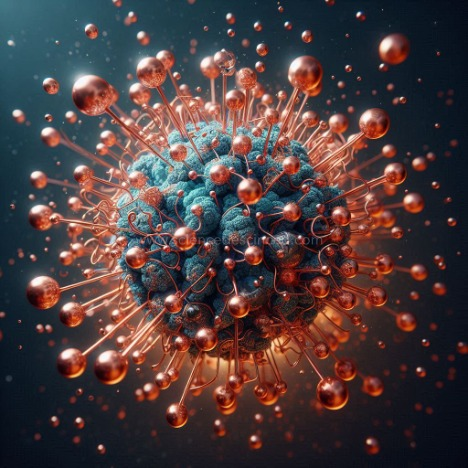
Imagine you are a virus particle floating through the air. You need to find a strategic landing spot; one that would allow easy transfer to unsuspecting humans. What’s that? A shiny door knob at a busy office building — perfect! All it takes is for someone to twist the door knob and then touch their eyes, nose or mouth. But something’s not right. The proteins that make up your body break down, and within minutes, you are dead.
Sounds like Science Fiction? At least, that is the scenario a team of materials scientists and microbiologists from University of Virginia hopes will play out to keep future pandemics like COVID-19 at bay.
Copper’s rep
When copper is exposed to air or water, it oxidizes and releases positively charged copper ions. When these ions cross paths with a virus particle, they:
- Punch holes in the virus’s outer membrane
- Wreak havoc in how their essential proteins function
- Destroy their genetic material
As you can imagine, the virus killing efficiency of copper is directly linked to the number of copper ions released.
Copper’s Kill Score
When scientists test how well copper surfaces kill viruses, they use a solution called “assay media” to carry the viruses. These are simply standardized solutions that keep the virus stable. However, they are very different from solutions that copper is likely to encounter in the real world, like sweat from our palms, or saliva from uncovered sneezes. Nevertheless, assay media were the obvious choice for several studies demonstrating Copper’s ability to kill viruses, going as far back as 1996 when copper ions were shown to pierce through the infamous AIDS virus.
Are we testing Copper right?
Dr. Carol Glover of the University of Virginia was not convinced we are. Along with a team of materials scientists and microbiologists, they compared how assay media performed against artificial perspiration — in other words, “fake sweat.”
The results were jaw-dropping. When tested in a solution of artificial sweat, copper killed half the viruses in just 17 minutes. It took copper over 90 minutes to kill the same amount of virus in traditional assay media. That is over 5 times longer! So, were we underestimating copper’s ability to kill viruses? Absolutely.
A tale of two oxides
As copper releases ions, it also forms of a layer of oxide on its surface. This oxide can be either Copper(I) Oxide (Cu2O) or Copper(II) Oxide (CuO). The first one red and the second, black. More importantly, Cu2O dissolves faster than CuO. In a potential virus battle, the quicker dissolving Cu2O will release way more copper ions than CuO, making the surface much more potent against the virus.
It turns out when fake sweat was used, the copper surface produced more Cu2O than CuO, The scenario was flipped when they used conventional assay media.
Quality over quantity
A thin layer of oxide should, in theory, let more ions escape. However, the Cu2O layer that formed in fake sweat was thick. Yet, it killed more viruses than the surface with assay media with a thin CuO layer. Why? The answer is “chelation” — a process where organic material sticks to metal ions.
If organic molecules in the virus carrying medium stick to copper ions, they are neutralized. These chelated ions can’t interact with, let alone kill viruses. The team found that though fake sweat released less copper ions from copper, these ions were free to attack the virus. In effect, copper simply becomes way more efficient at killing viruses in the presence of (fake) sweat.
Implications
- A lot of studies done in the past may have underestimated how quickly copper kills viruses in real-world scenarios.
- Environment matters; a copper door knob indoors may kill viruses better than a similar door knob outside, exposed to the elements.
- Copper alloys designed for antimicrobial applications must not only consider the number of copper ions released, but also whether the ions will be free to engage with the target virus particles.
Final thoughts
It was no secret that copper can kill viruses. However, this study throws new light on how it goes about it. By systematically comparing copper’s virus killing ability in conventional solutions versus fake sweat, Dr. Carol Glover and team has paved the way for new, more efficient, copper alloys to fight infectious diseases.
The next copper door knob you lay your sweaty palms on may be tilting the scales in the microscopic battle between copper and some of nature’s tiniest invaders. And it all started with a researcher questioning why copper was tested a certain way.
